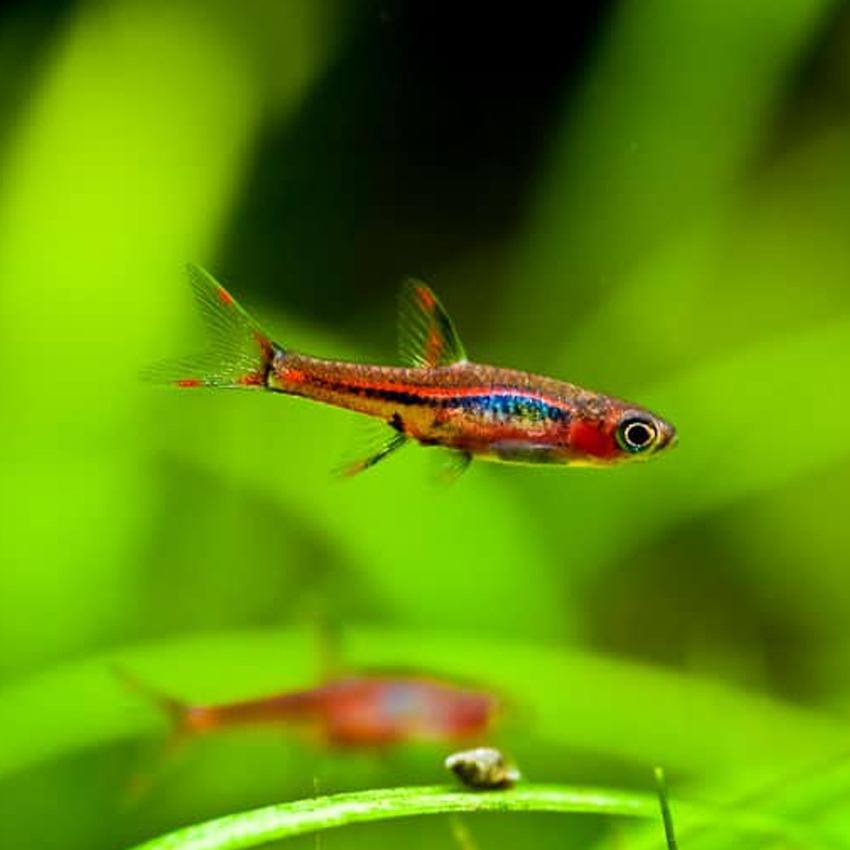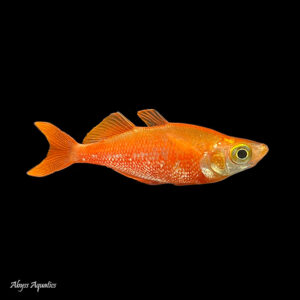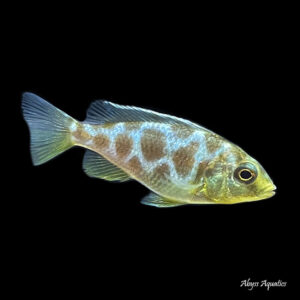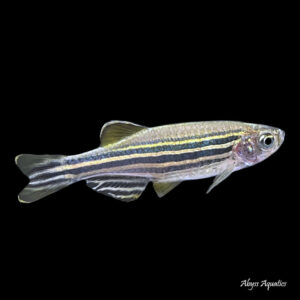Chilli Rasbora (Boraras brigittae) is a small freshwater fish with a very distinctive appearance. The fish has a slender body that is torpedo-shaped and laterally compressed. The maximum size of this species is only around 2cm (0.8in), with females being slightly larger than males.
The fish’s scales are small and shimmering with a silver-greenish hue. Its fins are transparent with a slight reddish tint, and the dorsal fin is relatively large in proportion to its body. The most distinctive feature of the Chilli Rasbora is the striking red coloration that runs along its body, from the head to the tail. This red coloration makes the fish stand out in any aquarium and makes them a popular choice among hobbyists.
The eyes of the Chilli Rasbora are relatively large compared to its small size, and they have a dark black coloration. The mouth is small, and the fish has a pointed snout. Its caudal fin is forked, and the anal fin is relatively small. The pectoral fins are transparent and fan-shaped, while the pelvic fins are positioned close to the anal fin and are also transparent.
Chilli Rasbora (Boraras brigittae) Natural Habitat
From a Chilli Rasbora’s viewpoint, their natural habitat would consist of slow-moving streams, ponds, and marshes in Southeast Asia, particularly in the Malay Peninsula and Thailand. The water would be clear, with low to moderate water flow, and the temperature would range from 23-28°C. The water would also be soft to slightly acidic, with a pH range of 6.0-7.0 and a hardness of 1-8 dH.
In their natural habitat, Chilli Rasboras would live among dense vegetation, such as aquatic plants, fallen leaves, and roots. The substrate would be sandy or muddy, with occasional rocks or roots. The vegetation provides hiding spots and breeding sites for the fish. The water would be shaded by overhanging vegetation, which would help keep the water temperature stable and reduce the amount of direct sunlight.
Chilli Rasboras would also share their natural habitat with other fish species, such as other Rasbora species, danios, and gobies. They would feed on small insects, crustaceans, and other small invertebrates that live among the vegetation and substrate. The natural habitat would also have occasional floods during the rainy season, which would provide new breeding sites and food sources for the fish.
Overall, Chilli Rasboras prefer a natural habitat that is heavily vegetated, with soft, acidic water and low to moderate water flow. They prefer to live in large groups and would feed on small invertebrates among the vegetation and substrate.
Keeping Chilli Rasbora Healthy
The Chilli Rasbora is a delicate fish that requires careful attention to water quality and temperature. It has a care level of moderate difficulty, and is best kept in a species-only tank or with other small, peaceful fish that won’t outcompete it for food. It prefers a pH range of 5.0-7.0 and a temperature range of 24-28°C.
Boraras brigittae Special Requirements and Feeding
Chilli Rasbora should be kept in a well-planted tank with a soft substrate and regular water changes to maintain optimal water quality. They are omnivores and prefer a varied diet of small live and frozen foods such as daphnia, and brine shrimp according to most sourses however instore we feed ours on JBL Novo bea, as well as JBL Pronovo Bel Grano Xxs 100ml Click
How Many Should I Keep?
Chilli Rasbora are schooling fish and should be kept in groups of at least 8-10 individuals to feel comfortable and secure.
Lighting Preference
The Chilli Rasbora does best in a dimly lit aquarium with plenty of hiding places, such as plants, driftwood, and rock formations.
Suitable Tank Mates for Boraras brigittae
Chili Rasbora, is a small, peaceful fish that can be kept with other small and peaceful species. Here are some suitable tank mates for Boraras brigittae:
- Other Small Rasboras: Since Boraras brigittae are peaceful and non-aggressive, they can be kept with other small rasboras, such as Harlequin Rasboras (Trigonostigma heteromorpha) and Emerald Dwarf Rasboras (Microrasbora erythromicron).
- Dwarf Corydoras: Dwarf Corydoras, such as Pygmy Corydoras (Corydoras pygmaeus) and Habrosus Corydoras (Corydoras habrosus), are small and peaceful catfish that can be kept with Boraras brigittae.
- Shrimp: Small shrimp, such as Cherry Shrimp (Neocaridina davidi) and Ghost Shrimp (Palaemonetes paludosus), can make good tank mates for Boraras brigittae. However, it’s important to note that some fish may view shrimp as food.
- Snails: Small snails, such as Nerite Snails (Neritina spp.) and Ramshorn Snails (Planorbella spp.), can also be kept with Boraras brigittae.
It’s important to ensure that all tank mates are small and peaceful, as Boraras brigittae can be easily intimidated by larger or more aggressive fish. Additionally, providing plenty of hiding places and plants in the aquarium can help reduce stress and provide places for fish to retreat if needed.
Breeding Chilli Rasbora
Breeding Chilli Rasbora can be a rewarding experience for aquarium enthusiasts. Here is a detailed guide on how to breed them successfully:
- Set up a breeding tank: Prepare a separate breeding tank with a capacity of at least 10 gallons. Ensure that the tank has a heater, a sponge filter, and some live plants for the fish to lay their eggs on.
- Select healthy breeding pairs: Choose healthy, mature, and sexually active breeding pairs. Ensure that the males and females are evenly matched in size.
- Condition the breeding pairs: Feed the breeding pairs high-quality live and frozen foods such as bloodworms, brine shrimp, and daphnia to condition them for breeding. You can also provide them with some commercial foods to supplement their diet.
- Introduce the breeding pairs: Introduce the breeding pairs into the breeding tank in the ratio of 1 male to 2-3 females. Ensure that the tank has plenty of hiding spots and plant cover for the fish to retreat to.
- Observe spawning behaviour: Once the breeding pairs are settled in the tank, observe their behaviour closely. Chilli Rasboras are egg scatterers, so the females will lay their eggs on the plants and substrate.
- Remove the breeding pairs: After spawning, remove the breeding pairs from the breeding tank to prevent them from eating the eggs.
- Incubate the eggs: The eggs will hatch in 24-36 hours, and the fry will become free-swimming in another 2-3 days. Provide them with infusoria or liquid fry food for the first few days, and then gradually transition them to finely crushed flakes and other small foods.
- Maintain water quality: Ensure that the water quality is maintained at optimal levels by performing regular water changes and monitoring the parameters such as temperature, pH, and ammonia levels.
Breeding Chilli Rasbora can be challenging, and it may take several attempts to achieve success. However, with patience and proper care, you can successfully breed these beautiful fish and enjoy the experience of watching their offspring grow.
Sexual Dimorphism
Male and female Chilli Rasbora are difficult to tell apart, but females tend to be slightly larger and rounder in the belly when carrying eggs.
Lifespan
The Chilli Rasbora has a lifespan of around 2-3 years in captivity with proper care.
Distribution
The Chilli Rasbora is a naturally occurring fish found in the slow-moving streams and pools of the Malay Peninsula. It is also commonly bred in captivity for the aquarium trade.
Summary
Overall, the Chilli Rasbora is a small and delicate freshwater fish that requires careful attention to water quality and temperature. With a well-planted tank and a varied diet, they can thrive in a peaceful community with other small species.





James (verified owner) –
Awesome nano fish, a nice school of these bring so much life to my 20 gallon heavily planted tank.
Tom (verified owner) –
Great little fish, can be a bit shy, and easily spooked by any tiny changes in the tank, but once they’ve relaxed a bit, a cloud of them weaving through a planted is gorgeous. Despite being tiny they’re pretty active and will use the space they’re given, so a nice long tank will get the best out of them.
Got 15 of them for a 25 gal, coloured up lovely in the couple of months I’ve had them.
Simon jackson (verified owner) –
My shoal of 10 arrived yesterday all happy and healthy. Despite my new dwarf gourmi trying to snack on them at first after feeding they all settled down, they now follow him when he is hoovering up any feed from the tank bottom and are happy to shoal up or swim apart for a bit in my heavily planted 9g. Already starting to colour up nicely, going to look awesome when fully grown.